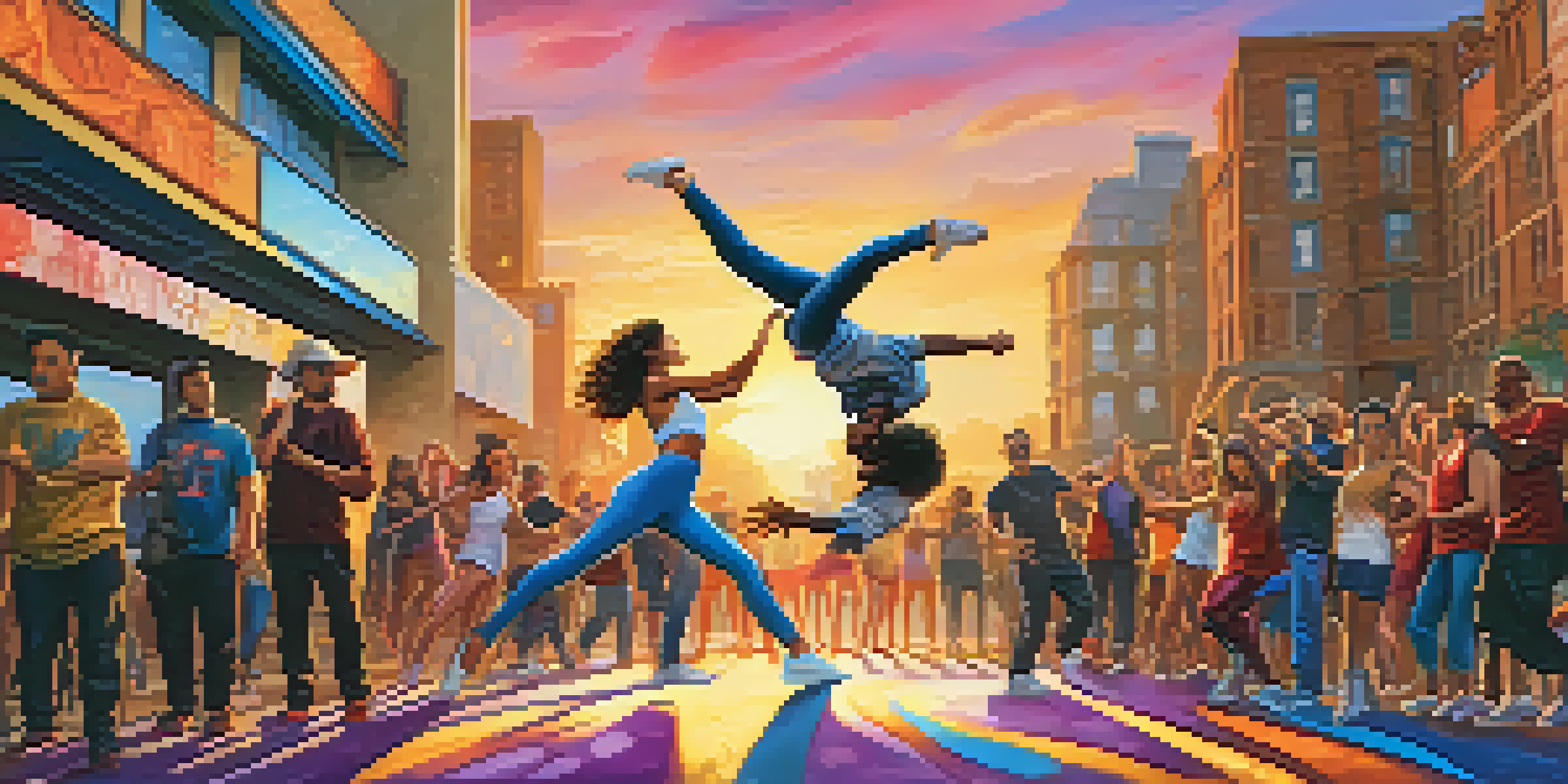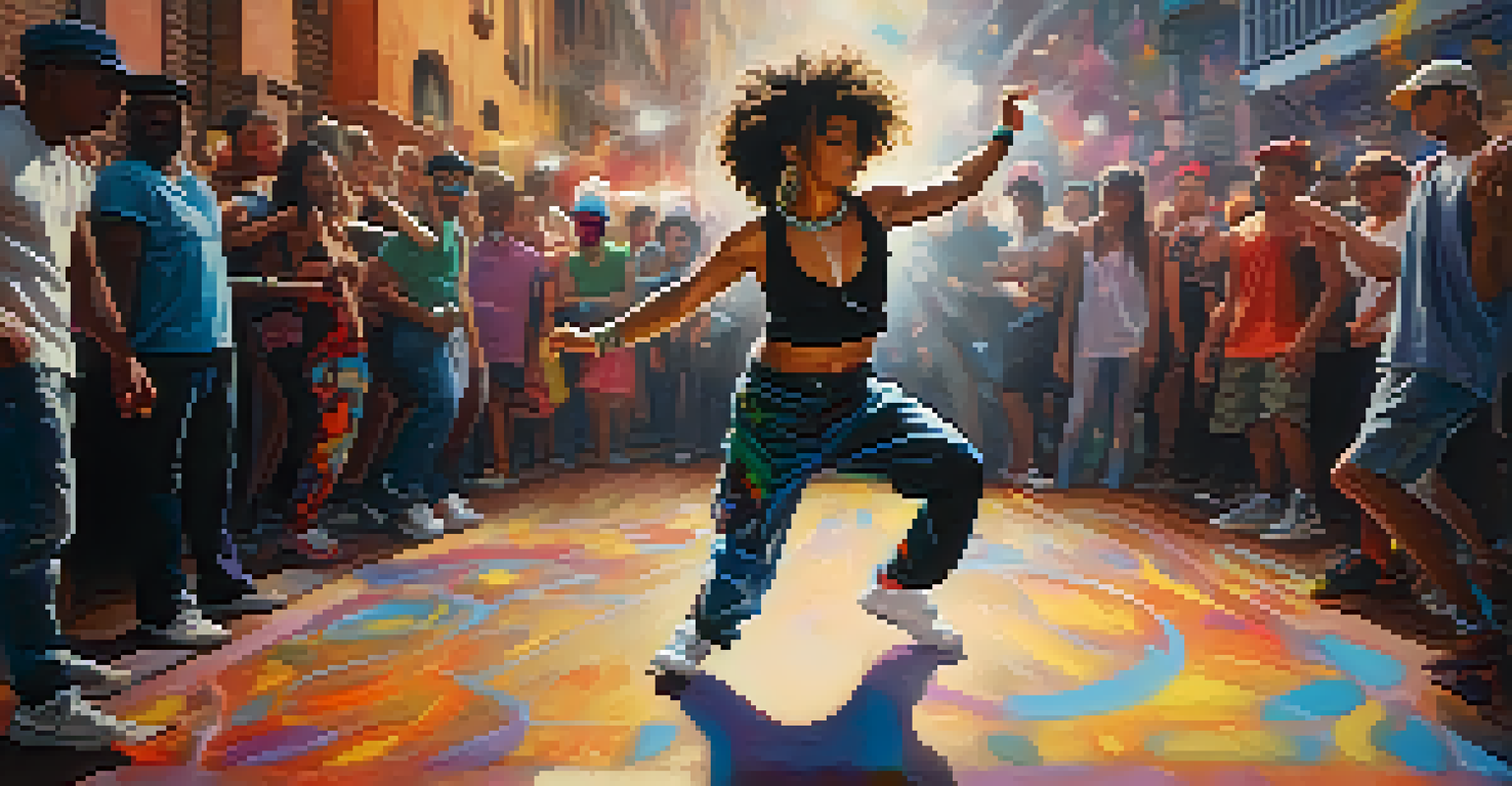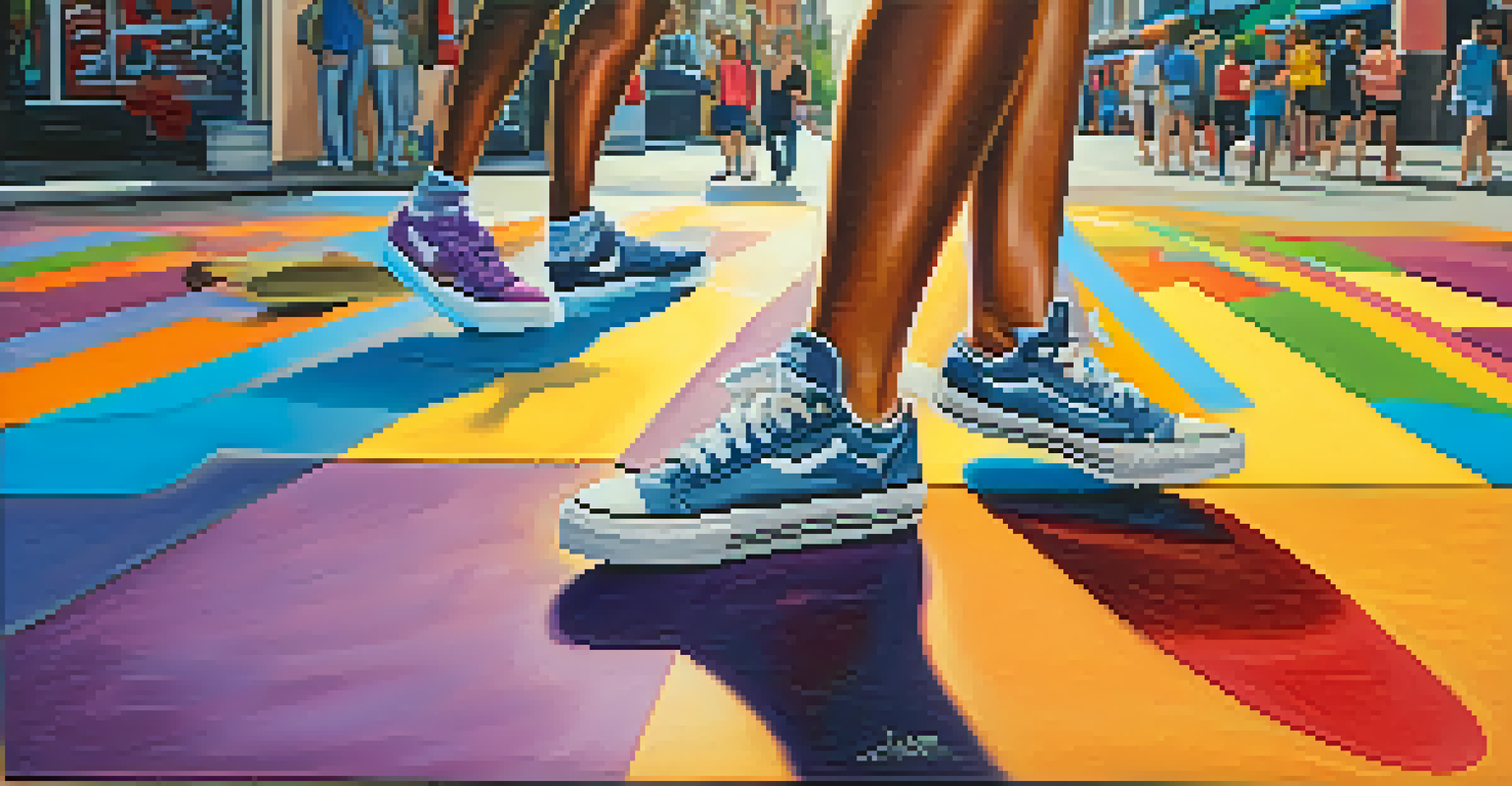Street Dance Battles: A Cultural Phenomenon

The Rise of Street Dance Battles: A Historical Overview
Street dance battles have roots that trace back to the 1970s in New York City, where hip-hop culture began to flourish. These spontaneous dance-offs were often held in parks and on street corners, providing a platform for dancers to express themselves. As the style evolved, so did the battles, becoming a structured competition that showcased skill, creativity, and personality.
Dance is the hidden language of the soul.
The emergence of breakdancing, locking, and popping contributed to the competitive nature of street dance battles. Dancers would challenge each other, leading to a rich tapestry of styles and techniques that pushed the boundaries of movement. This evolution mirrored the cultural shifts occurring in urban communities, making battles a vital part of the hip-hop narrative.
Today, street dance battles have transcended their local origins, influencing global dance culture. Competitions like Red Bull BC One and Juste Debout attract dancers from all over the world, allowing for cross-cultural exchange and innovation. The battles now serve not only as competitions but also as celebrations of diversity and creativity.
Elements of a Street Dance Battle: What to Expect
A street dance battle is more than just a competition; it's an electrifying showcase of talent and emotion. Dancers typically face off in front of a live audience, with each performer taking turns to impress the judges and spectators. The atmosphere is charged with anticipation, as each move can sway the outcome of the battle.

The battles often incorporate various elements such as freestyling, where dancers improvise their moves based on the music and the opponent's style. This spontaneous creativity is a hallmark of street dance battles, making each performance unique. Additionally, the use of props, costumes, and even the environment can influence a dancer's approach and presentation.
Street Dance Battles' Cultural Impact
Street dance battles serve as a vital platform for cultural expression and social change, particularly within marginalized communities.
Judges play a crucial role in determining the winner, often assessing criteria like originality, technique, and stage presence. The interaction between dancers and the audience creates an engaging experience, as spectators cheer, clap, and react to the performances. This sense of community enhances the vibrancy of the event, making it a true celebration of dance.
Cultural Significance: More Than Just Dance
Street dance battles are a reflection of cultural expression and identity, particularly within marginalized communities. They allow dancers to showcase their heritage and tell stories through movement, often addressing social issues and personal experiences. This connection to culture makes battles a powerful tool for social change and awareness.
The rhythm of the dance speaks to the rhythm of the heart.
Moreover, the battles promote inclusivity, bringing together people from different backgrounds and encouraging collaboration. Dancers often share techniques and styles, fostering a sense of unity within the community. This spirit of camaraderie is evident during events, where rivalries can transform into friendships, highlighting the positive impact of dance.
The global reach of street dance battles has also contributed to a greater understanding and appreciation of diverse cultures. As dancers travel and compete internationally, they exchange ideas and traditions, enriching the art form. This cultural dialogue not only elevates street dance but also cultivates respect and recognition for its origins.
The Role of Social Media in Street Dance Battles
In the digital age, social media has transformed the landscape of street dance battles. Platforms like Instagram and TikTok allow dancers to share their performances with a global audience, breaking geographical barriers. This visibility has helped elevate lesser-known dancers to stardom, giving them opportunities they might not have had otherwise.
Social media also fosters a sense of community among dancers, as they can connect, collaborate, and support each other's journeys. Hashtags like #DanceChallenge have gone viral, encouraging participation from both seasoned dancers and beginners alike. This democratization of dance means that anyone can join the conversation and showcase their talent.
Social Media's Role in Dance
Social media has revolutionized street dance by enabling global exposure for dancers and fostering a sense of community among them.
However, with the rise of social media, there's also a challenge to maintain authenticity. The pressure to create viral content can sometimes overshadow the true essence of street dance battles. It's essential for dancers to remember the roots of their craft, ensuring that their performances remain genuine and reflective of their personal stories.
Famous Street Dance Battles: Iconic Moments
Throughout history, certain battles have left an indelible mark on the street dance scene. One iconic moment occurred during the 1981 battle between the Rock Steady Crew and the New York City Breakers, which was not only a showcase of talent but also a cultural exchange that highlighted the burgeoning hip-hop scene. This battle set the stage for future competitions, establishing a benchmark for what street dance battles could achieve.
Another unforgettable moment was the 2005 battle between the legendary dancer Bboy Hong 10 and Bboy Lilou at the Red Bull BC One. Their electrifying performances captivated audiences worldwide and showcased the artistry and athleticism that street dance embodies. Such moments have inspired countless dancers to push their limits and innovate within their styles.
These iconic battles serve as a reminder of the artistry inherent in street dance. They capture the spirit of competition, creativity, and community, while also highlighting the evolution of the art form. Each battle contributes to the narrative of street dance, paving the way for future generations to explore and redefine their craft.
Challenges Faced by Street Dancers
Despite the vibrancy of street dance battles, dancers face numerous challenges in their pursuit of success. One significant hurdle is the lack of funding and resources, which can limit opportunities for training and exposure. Many dancers rely on grassroots initiatives to organize events, often working tirelessly to create platforms for themselves and their peers.
Additionally, the competitive nature of street dance can lead to intense pressure and burnout. Dancers often feel the need to constantly outdo themselves and remain relevant in an ever-evolving landscape. This pressure can detract from the joy of dancing, turning a passion into a source of stress.
Challenges Facing Street Dancers
Street dancers encounter significant challenges, including funding shortages, intense competition pressure, and a struggle for recognition in the broader dance community.
Moreover, the fight for recognition within the broader dance community continues. Street dancers often struggle to gain respect from traditional dance institutions, which can undermine their contributions to the art form. Advocating for inclusivity and respect is crucial for the future of street dance, ensuring that all styles and backgrounds are celebrated.
The Future of Street Dance Battles: Trends and Innovations
Looking ahead, the future of street dance battles is bright, with trends and innovations shaping the landscape. The integration of technology, such as virtual reality and live streaming, is creating new opportunities for dancers to connect with audiences. These advancements not only enhance the viewing experience but also allow dancers to reach global platforms without geographical constraints.
Additionally, the rise of dance festivals and competitions that embrace diversity is fostering a more inclusive environment. Events like the World Dance Sport Federation's World Street Dance Championships are gaining popularity, providing a legitimate stage for street dancers to shine. This recognition is essential for the growth and evolution of street dance as a respected art form.

Moreover, the blending of street dance with other genres is creating exciting new styles and forms of expression. Collaborations between street dancers and contemporary artists are pushing the boundaries of creativity, leading to innovative performances that captivate audiences. As street dance continues to evolve, its influence on popular culture and the dance community will undoubtedly endure.